The Cambridge History of China. Vol. 13: Republican China 1912-1949, Part 2
Подождите немного. Документ загружается.

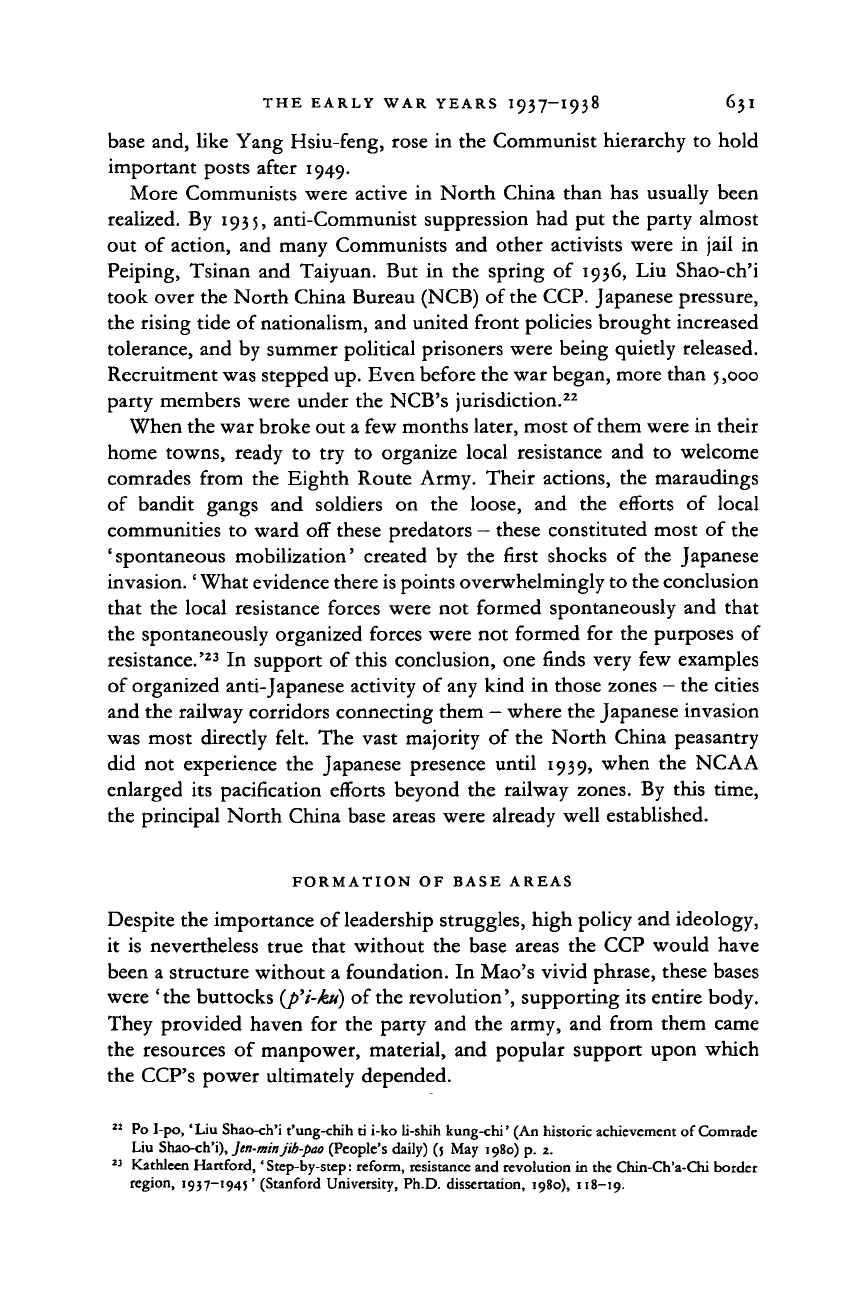
THE EARLY WAR YEARS 1937—1938 631
base and, like Yang Hsiu-feng, rose in the Communist hierarchy to hold
important posts after 1949.
More Communists were active in North China than has usually been
realized. By 1935, anti-Communist suppression had put the party almost
out of action, and many Communists and other activists were in jail in
Peiping, Tsinan and Taiyuan. But in the spring of 1936, Liu Shao-ch'i
took over the North China Bureau (NCB) of the CCP. Japanese pressure,
the rising tide of nationalism, and united front policies brought increased
tolerance, and by summer political prisoners were being quietly released.
Recruitment was stepped up. Even before the war began, more than
5,000
party members were under the NCB's jurisdiction.
22
When the war broke out a few months later, most of them were in their
home towns, ready to try to organize local resistance and to welcome
comrades from the Eighth Route Army. Their actions, the maraudings
of bandit gangs and soldiers on the loose, and the efforts of local
communities to ward off these predators - these constituted most of the
'spontaneous mobilization' created by the first shocks of the Japanese
invasion.' What evidence there is points overwhelmingly to the conclusion
that the local resistance forces were not formed spontaneously and that
the spontaneously organized forces were not formed for the purposes of
resistance.'
23
In support of this conclusion, one finds very few examples
of organized anti-Japanese activity of any kind in those zones - the cities
and the railway corridors connecting them - where the Japanese invasion
was most directly felt. The vast majority of the North China peasantry
did not experience the Japanese presence until 1939, when the NCAA
enlarged its pacification efforts beyond the railway zones. By this time,
the principal North China base areas were already well established.
FORMATION OF BASE AREAS
Despite the importance of leadership struggles, high policy and ideology,
it is nevertheless true that without the base areas the CCP would have
been a structure without a foundation. In Mao's vivid phrase, these bases
were 'the buttocks (p'i-ku) of the revolution', supporting its entire body.
They provided haven for the party and the army, and from them came
the resources of manpower, material, and popular support upon which
the CCP's power ultimately depended.
11
Po I-po, 'Liu Shao-ch'i t'ung-chih ti i-ko li-shih kung-chi' (An historic achievement of Comrade
Liu Shao-ch'i), }en-min jib-pao (People's daily) (5 May 1980) p. 2.
23
Kathleen Hartford, 'Step-by-step: reform, resistance and revolution in the Chin-Ch'a-Chi border
region, 1937-1945' (Stanford University, Ph.D. dissertation, 1980), 118-19.
Cambridge Histories Online © Cambridge University Press, 2008

632 THE CHINESE COMMUNIST MOVEMENT, 1937—1945
1.
Shen-Kan-Ning
(an abbreviation for Shensi-Kansu-Ninghsia, i.e., the
headquarters or 'Yenan area'). This was the nerve centre of the CCP, from
the time of Mao's arrival at the end of the Long March in October 1935
until its capital, Yenan, was abandoned to the Nationalists in March 1947.
As the only base in existence prior to the Sino-Japanese War, it produced
the most voluminous and easily accessible materials on the CCP and was
the CCP area most frequently visited by foreign observers, from Edgar
Snow's trip in 1936-out of which came Red star
over China
-to the
journalists, foreign service officers, and military personnel of the US
Military Observer Group ('Dixie Mission'; see below pp. 712-14) in late
1944 and 1945.
Shen-Kan-Ning (shown in map 10) was one of the most barren,
chronically depressed, and sparsely populated regions in China. Despite
its broad area (roughly the si2e of Ohio), it had only about 1.4 million
inhabitants. Most were desperately poor, yet one estimate claimed that
landlords and rich peasants comprised 12 per cent of the population and
owned 46 per cent of the land. Agriculture was precarious, with a short
growing season and scanty, unpredictable rainfall, which might
nevertheless come in sudden cloudbursts to wash away crops and cut
ravines in the defrosted loess slopes. Between 1928 and 1933, famine had
stalked north-west China, including Shen-Kan-Ning (SKN); millions died
and much land fell into disuse. Severe earthquakes might periodically
collapse the dwellings tunnelled into loess cliffs. Along with the harshness
of nature, the region had long been plagued by unrest, disorder and
violence. It had never fully recovered from the terrible Muslim rebellions
of the 1870s. Banditry and warlordism were endemic.
Several circumstances made Shen-Kan-Ning a special case, not repre-
sentative of other base areas. (1) As the headquarters area of the CCP,
most of it had passed through the agrarian revolution (confiscation of
landlords' land) prior to the adoption of the milder united front land
policy, so that local elite opposition was less than in other bases. (2) SKN
was the only base beyond the furthest advance of Japanese armies.
Although Yenan was bombed a few times, SKN was spared the problems
of security and survival with which other base areas had to cope. (3) The
military situation was simpler in SKN because central government and
puppet forces were absent. (4) Where the bases behind Japanese lines were
a mix of often scattered areas, variously consolidated, semi-consolidated,
or guerrilla zones, SKN was almost entirely consolidated. (5) Because
SKN was sparsely populated and backward, measures for improved
livelihood could be more effective and more obvious than in other bases.
Garrison units of the 8RA were freer too, to assist in these efforts.
Cambridge Histories Online © Cambridge University Press, 2008

THE EARLY WAR YEARS I937—1938
633
• County (hsien)capitals
© Provincial capital
I"™"
1
Great Wall
MttKi Land redistribution completed
V//////A
Land redistribution partially completed
50 miles
MAP
JO.
Shen-Kan-Ning: basic data
Territory and administration: Population and personnel:
5 sub-regions Total population: c. 1.4 million
15 counties
{hsien)
in 1937, expanding to 29 Armed forces in 1941: 8RA, 18,000;
by 1941 public security, 15,000; militia
self-
266 districts
(eb'ff),
1,549 townships
(bsiang)
defence, 224,000
by 1941 Party/government,
8,000
Sources: Mark Selden, The Yenan
may
in
revolutionary
China, 102. Basic data is taken from
Selden and from Andrew Watson, Mao
Zedong
and the political
economy
of the border region:
a translation of Mao's 'Economic and
financial
problems'', 12-15.
Cambridge Histories Online © Cambridge University Press, 2008
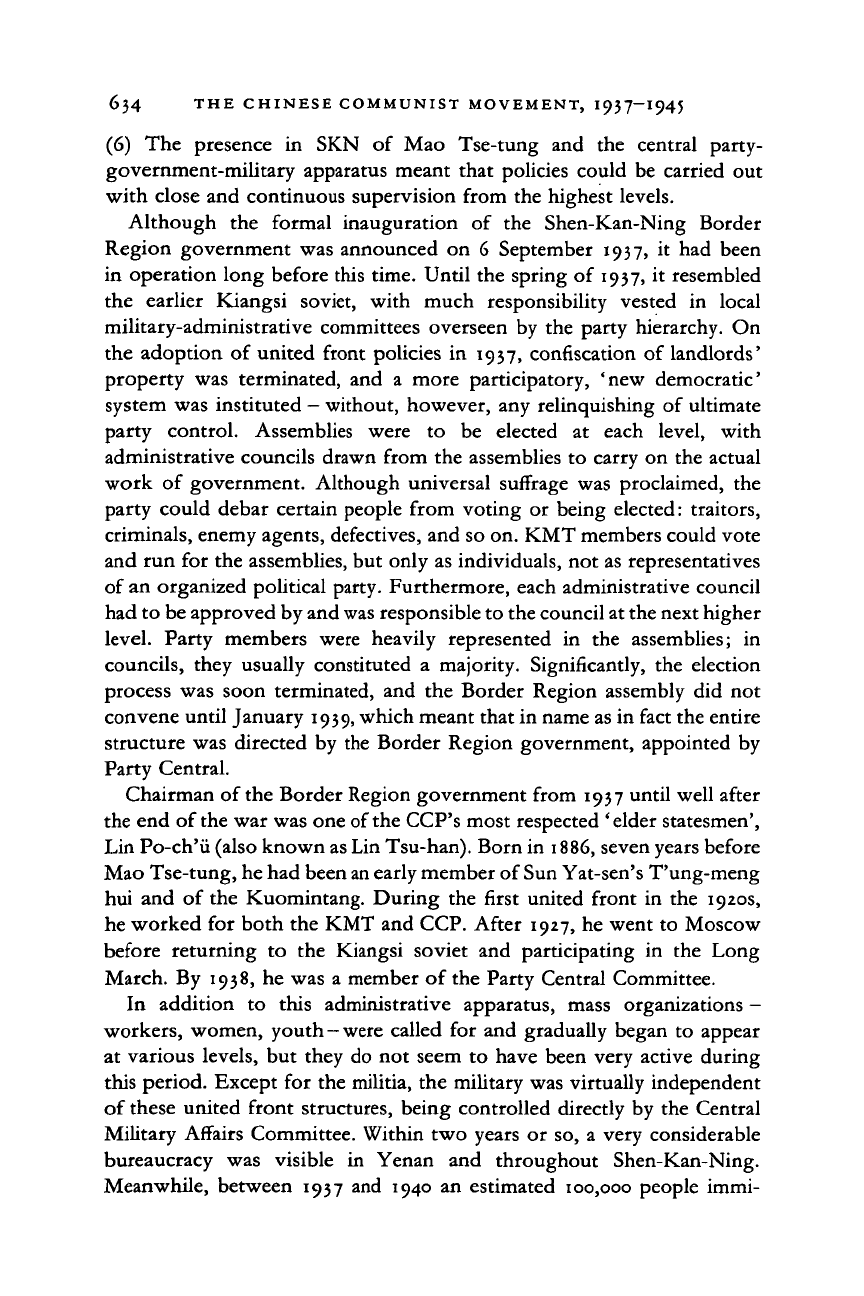
634
THE
CHINESE COMMUNIST MOVEMENT, 1937-1945
(6) The presence in SKN of Mao Tse-tung and the central party-
government-military apparatus meant that policies could be carried out
with close and continuous supervision from the highest levels.
Although the formal inauguration of the Shen-Kan-Ning Border
Region government was announced on 6 September 1937, it had been
in operation long before this time. Until the spring of 1937, it resembled
the earlier Kiangsi soviet, with much responsibility vested in local
military-administrative committees overseen by the party hierarchy. On
the adoption of united front policies in 1937, confiscation of landlords'
property was terminated, and a more participatory, 'new democratic'
system was instituted - without, however, any relinquishing of ultimate
party control. Assemblies were to be elected at each level, with
administrative councils drawn from the assemblies to carry on the actual
work of government. Although universal suffrage was proclaimed, the
party could debar certain people from voting or being elected: traitors,
criminals, enemy agents, defectives, and so on. KMT members could vote
and run for the assemblies, but only as individuals, not as representatives
of an organized political party. Furthermore, each administrative council
had to be approved by and
was
responsible to the council at the next higher
level. Party members were heavily represented in the assemblies; in
councils, they usually constituted a majority. Significantly, the election
process was soon terminated, and the Border Region assembly did not
convene until January
1939,
which meant that in name as in fact the entire
structure was directed by the Border Region government, appointed by
Party Central.
Chairman of the Border Region government from 1937 until well after
the end of the war was one of the CCP's most respected ' elder statesmen',
Lin Po-ch'vi (also known as Lin Tsu-han). Born in 1886, seven years before
Mao Tse-tung, he had been an early member of Sun Yat-sen's T'ung-meng
hui and of the Kuomintang. During the first united front in the 1920s,
he worked for both the KMT and CCP. After 1927, he went to Moscow
before returning to the Kiangsi soviet and participating in the Long
March. By 1938, he was a member of the Party Central Committee.
In addition to this administrative apparatus, mass organizations -
workers, women, youth-were called for and gradually began to appear
at various levels, but they do not seem to have been very active during
this period. Except for the militia, the military was virtually independent
of these united front structures, being controlled directly by the Central
Military Affairs Committee. Within two years or so, a very considerable
bureaucracy was visible in Yenan and throughout Shen-Kan-Ning.
Meanwhile, between 1937 and 1940 an estimated 100,000 people immi-
Cambridge Histories Online © Cambridge University Press, 2008
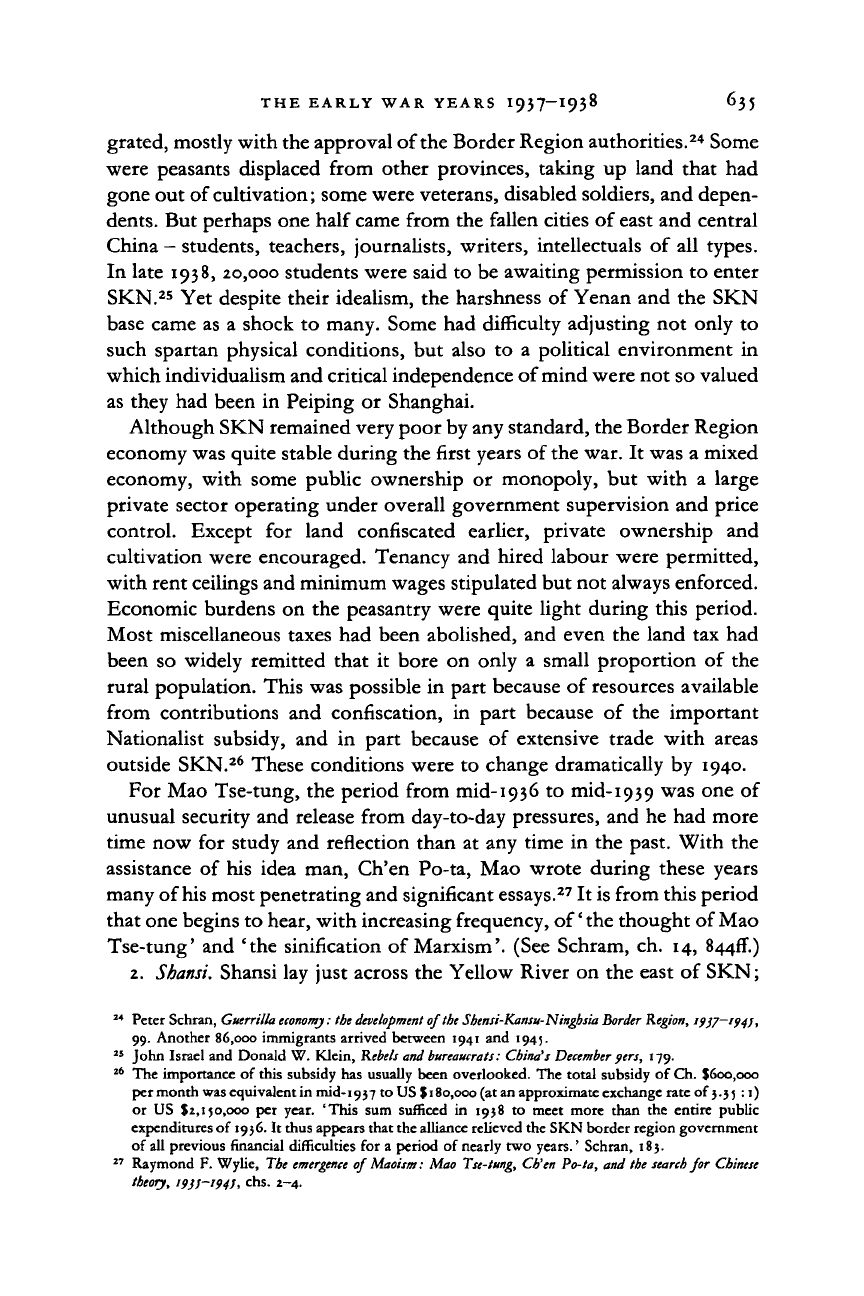
THE EARLY WAR YEARS I937-I938 635
grated, mostly with the approval of the Border Region authorities.
24
Some
were peasants displaced from other provinces, taking up land that had
gone out of cultivation; some were veterans, disabled soldiers, and depen-
dents.
But perhaps one half came from the fallen cities of east and central
China - students, teachers, journalists, writers, intellectuals of all types.
In late 1938, 20,000 students were said to be awaiting permission to enter
SKN.
2S
Yet despite their idealism, the harshness of Yenan and the SKN
base came as a shock to many. Some had difficulty adjusting not only to
such spartan physical conditions, but also to a political environment in
which individualism and critical independence of mind were not so valued
as they had been in Peiping or Shanghai.
Although SKN remained very poor by any standard, the Border Region
economy was quite stable during the first years of the war. It was a mixed
economy, with some public ownership or monopoly, but with a large
private sector operating under overall government supervision and price
control. Except for land confiscated earlier, private ownership and
cultivation were encouraged. Tenancy and hired labour were permitted,
with rent ceilings and minimum wages stipulated but not always enforced.
Economic burdens on the peasantry were quite light during this period.
Most miscellaneous taxes had been abolished, and even the land tax had
been so widely remitted that it bore on only a small proportion of the
rural population. This was possible in part because of resources available
from contributions and confiscation, in part because of the important
Nationalist subsidy, and in part because of extensive trade with areas
outside SKN.
26
These conditions were to change dramatically by 1940.
For Mao Tse-tung, the period from mid-1936 to mid-1939 was one of
unusual security and release from day-to-day pressures, and he had more
time now for study and reflection than at any time in the past. With the
assistance of his idea man, Ch'en Po-ta, Mao wrote during these years
many of his most penetrating and significant essays.
27
It is from this period
that one begins to hear, with increasing frequency, of' the thought of Mao
Tse-tung' and 'the sinification of Marxism'. (See Schram, ch. 14, 844ft".)
2.
Shansi.
Shansi lay just across the Yellow River on the east of SKN;
24
Peter Schran, Guerrilla economy:
the
development of the Sbensi-Kansu-Ningbsia Border Region, 19)7—1941,
99.
Another 86,000 immigrants arrived between
1941 and 1945.
25
John Israel
and
Donald
W.
Klein, Rebels
and
bureaucrats: China's December 9ers,
179.
26
The
importance
of
this subsidy
has
usually been overlooked.
The
total subsidy
of
Ch. $600,000
per month was equivalent
in
mid-1937
to US Ji
80,000 (at an approximate exchange rate
of
3.35
:1)
or
US
$2,150,000
per
year. 'This
sum
sufficed
in 1938 to
meet more than
the
entire public
expenditures
of
1936.
It
thus appears that
the
alliance relieved
the SKN
border region government
of
all
previous financial difficulties
for a
period
of
nearly
two
years.' Schran,
183.
27
Raymond F. Wylie, The
emergence
of Maoism: Mao Tse-tung, Cb'en Po-ta, and the
search
for Chinese
theory, 19)1-194), chs. 2-4.
Cambridge Histories Online © Cambridge University Press, 2008
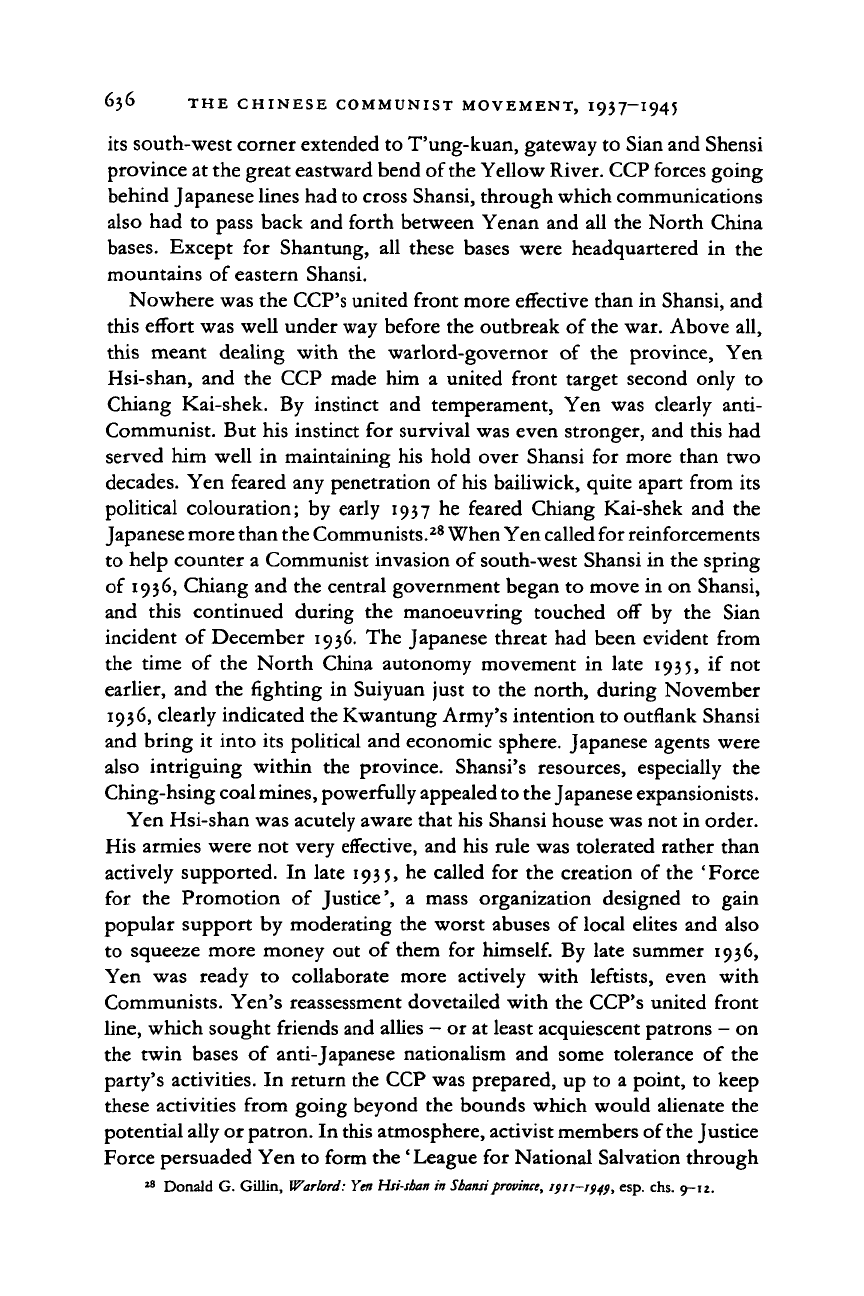
636 THE CHINESE COMMUNIST MOVEMENT, I937-I945
its south-west corner extended to T'ung-kuan, gateway to Sian and Shensi
province at the great eastward bend of the Yellow River. CCP forces going
behind Japanese lines had to cross Shansi, through which communications
also
had to
pass back and forth between Yenan
and all the
North China
bases.
Except
for
Shantung,
all
these bases were headquartered
in the
mountains
of
eastern Shansi.
Nowhere was the CCP's united front more effective than
in
Shansi,
and
this effort was well under way before
the
outbreak
of
the war. Above all,
this meant dealing with
the
warlord-governor
of the
province,
Yen
Hsi-shan,
and the CCP
made
him a
united front target second only
to
Chiang Kai-shek.
By
instinct
and
temperament,
Yen was
clearly anti-
Communist.
But
his instinct
for
survival was even stronger,
and
this
had
served
him
well
in
maintaining
his
hold over Shansi
for
more than
two
decades. Yen feared any penetration
of
his bailiwick, quite apart from
its
political colouration;
by
early 1937
he
feared Chiang Kai-shek
and the
Japanese more than the Communists.
28
When Yen called for reinforcements
to help counter
a
Communist invasion
of
south-west Shansi
in
the spring
of 1936, Chiang and the central government began
to
move
in on
Shansi,
and this continued during
the
manoeuvring touched
off by the
Sian
incident
of
December 1936.
The
Japanese threat
had
been evident from
the time
of the
North China autonomy movement
in
late 1935,
if not
earlier,
and the
fighting
in
Suiyuan just
to the
north, during November
1936,
clearly indicated the Kwantung Army's intention
to
outflank Shansi
and bring
it
into
its
political and economic sphere. Japanese agents were
also intriguing within
the
province. Shansi's resources, especially
the
Ching-hsing coal
mines,
powerfully appealed to the Japanese expansionists.
Yen Hsi-shan was acutely aware that his Shansi house was not
in
order.
His armies were
not
very effective,
and
his rule was tolerated rather than
actively supported.
In
late 1935,
he
called
for the
creation
of
the 'Force
for
the
Promotion
of
Justice',
a
mass organization designed
to
gain
popular support
by
moderating
the
worst abuses
of
local elites
and
also
to squeeze more money
out of
them
for
himself.
By
late summer
1936,
Yen
was
ready
to
collaborate more actively with leftists, even with
Communists. Yen's reassessment dovetailed with
the
CCP's united front
line,
which sought friends and allies
- or at
least acquiescent patrons
- on
the twin bases
of
anti-Japanese nationalism
and
some tolerance
of the
party's activities.
In
return the CCP was prepared,
up to a
point,
to
keep
these activities from going beyond
the
bounds which would alienate
the
potential ally or patron. In this atmosphere, activist members of the Justice
Force persuaded Yen
to
form the
'
League
for
National Salvation through
18
Donald
G.
Gillin,
Warlord:
Yen Hsi-sban
in
Sbansiprovince,
ifii—ifjf,
esp. chs. 9-12.
Cambridge Histories Online © Cambridge University Press, 2008
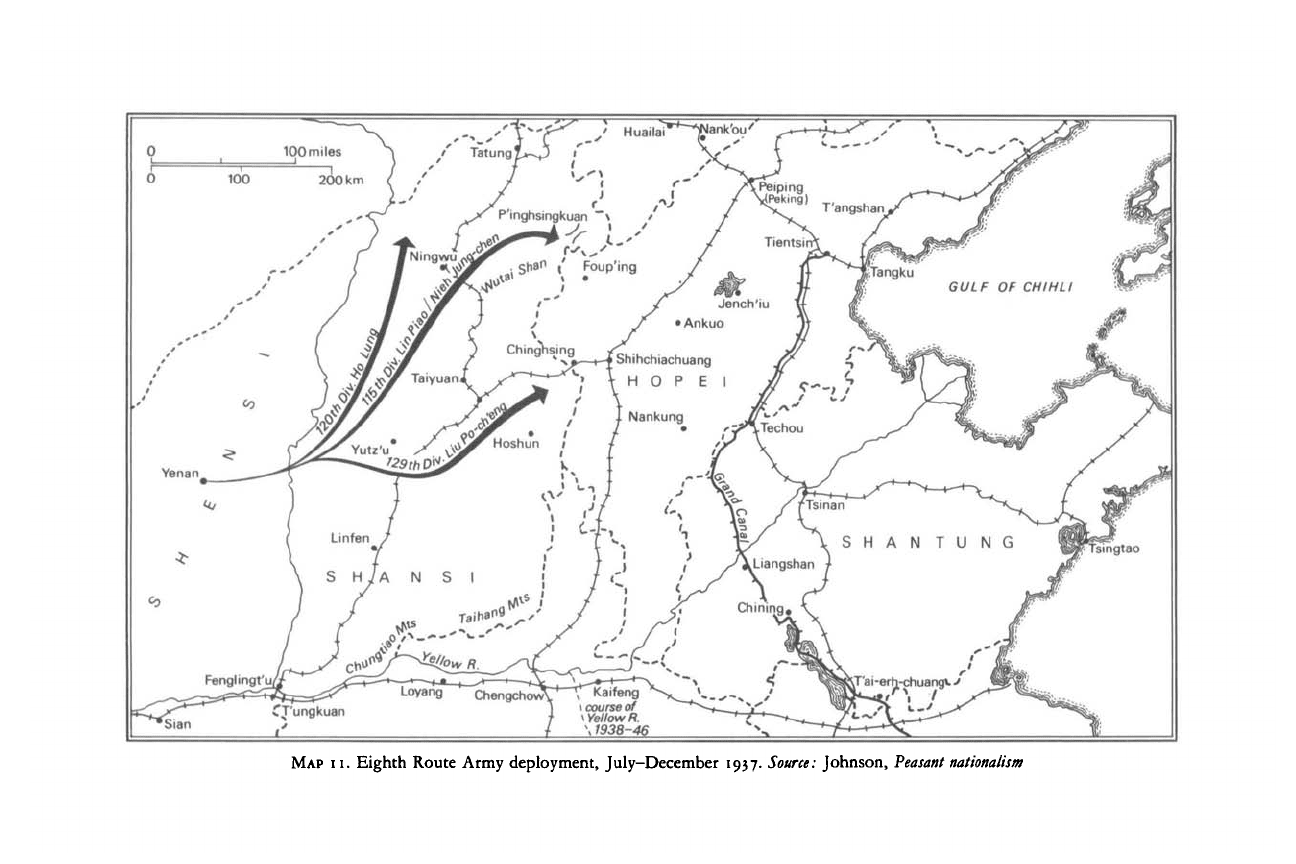
MAP
11. Eighth Route Army deployment, July-December 1937.
Source:
Johnson,
Peasant nationalism
Cambridge Histories Online © Cambridge University Press, 2008
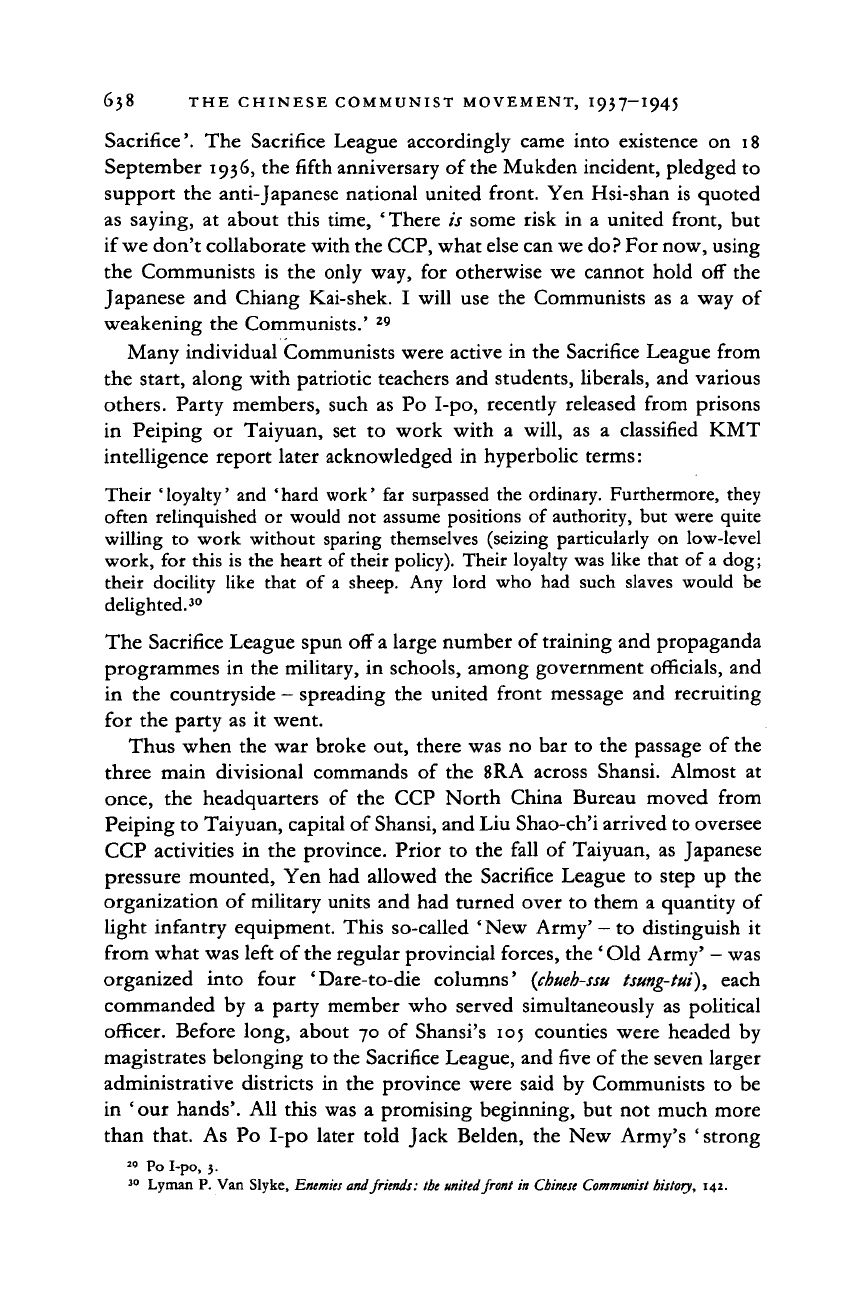
638 THE CHINESE COMMUNIST MOVEMENT, I937—1945
Sacrifice'.
The
Sacrifice League accordingly came into existence
on 18
September 1936,
the
fifth anniversary
of
the Mukden incident, pledged
to
support
the
anti-Japanese national united front.
Yen
Hsi-shan
is
quoted
as saying,
at
about this time, 'There
is
some risk
in a
united front,
but
if we don't collaborate with the CCP, what else can we do? For now, using
the Communists
is the
only
way, for
otherwise
we
cannot hold
off the
Japanese
and
Chiang Kai-shek.
I
will
use the
Communists
as a way of
weakening
the
Communists.'
29
Many individual Communists were active
in the
Sacrifice League from
the start, along with patriotic teachers
and
students, liberals,
and
various
others. Party members, such
as Po I-po,
recently released from prisons
in Peiping
or
Taiyuan,
set to
work with
a
will,
as a
classified
KMT
intelligence report later acknowledged
in
hyperbolic terms:
Their 'loyalty'
and
'hard work'
far
surpassed
the
ordinary. Furthermore, they
often relinquished
or
would
not
assume positions
of
authority,
but
were quite
willing
to
work without sparing themselves (seizing particularly
on
low-level
work,
for
this
is the
heart
of
their policy). Their loyalty was like that
of
a
dog;
their docility like that
of a
sheep.
Any
lord
who had
such slaves would
be
delighted.
30
The Sacrifice League spun
off
a
large number
of
training
and
propaganda
programmes
in the
military,
in
schools, among government officials,
and
in
the
countryside
-
spreading
the
united front message
and
recruiting
for
the
party
as it
went.
Thus when
the war
broke
out,
there was
no bar to the
passage
of
the
three main divisional commands
of the 8RA
across Shansi. Almost
at
once,
the
headquarters
of the CCP
North China Bureau moved from
Peiping
to
Taiyuan, capital
of
Shansi, and Liu Shao-ch'i arrived
to
oversee
CCP activities
in the
province. Prior
to the
fall
of
Taiyuan,
as
Japanese
pressure mounted,
Yen had
allowed
the
Sacrifice League
to
step
up the
organization
of
military units
and had
turned over
to
them
a
quantity
of
light infantry equipment. This so-called ' New Army'
- to
distinguish
it
from what was left
of
the regular provincial forces, the
'
Old Army'
—
was
organized into four 'Dare-to-die columns'
(chueh-ssu
tsung-tui), each
commanded
by a
party member
who
served simultaneously
as
political
officer. Before long, about
70 of
Shansi's
105
counties were headed
by
magistrates belonging
to
the Sacrifice League,
and
five
of
the seven larger
administrative districts
in the
province were said
by
Communists
to be
in
'our
hands'.
All
this
was a
promising beginning,
but not
much more
than that.
As Po I-po
later told Jack Belden,
the New
Army's 'strong
» Po I-po,
3.
30
Lyman
P. Van
Slyke, Enemies and friends:
the
united front
in
Chinese Communist history,
142.
Cambridge Histories Online © Cambridge University Press, 2008
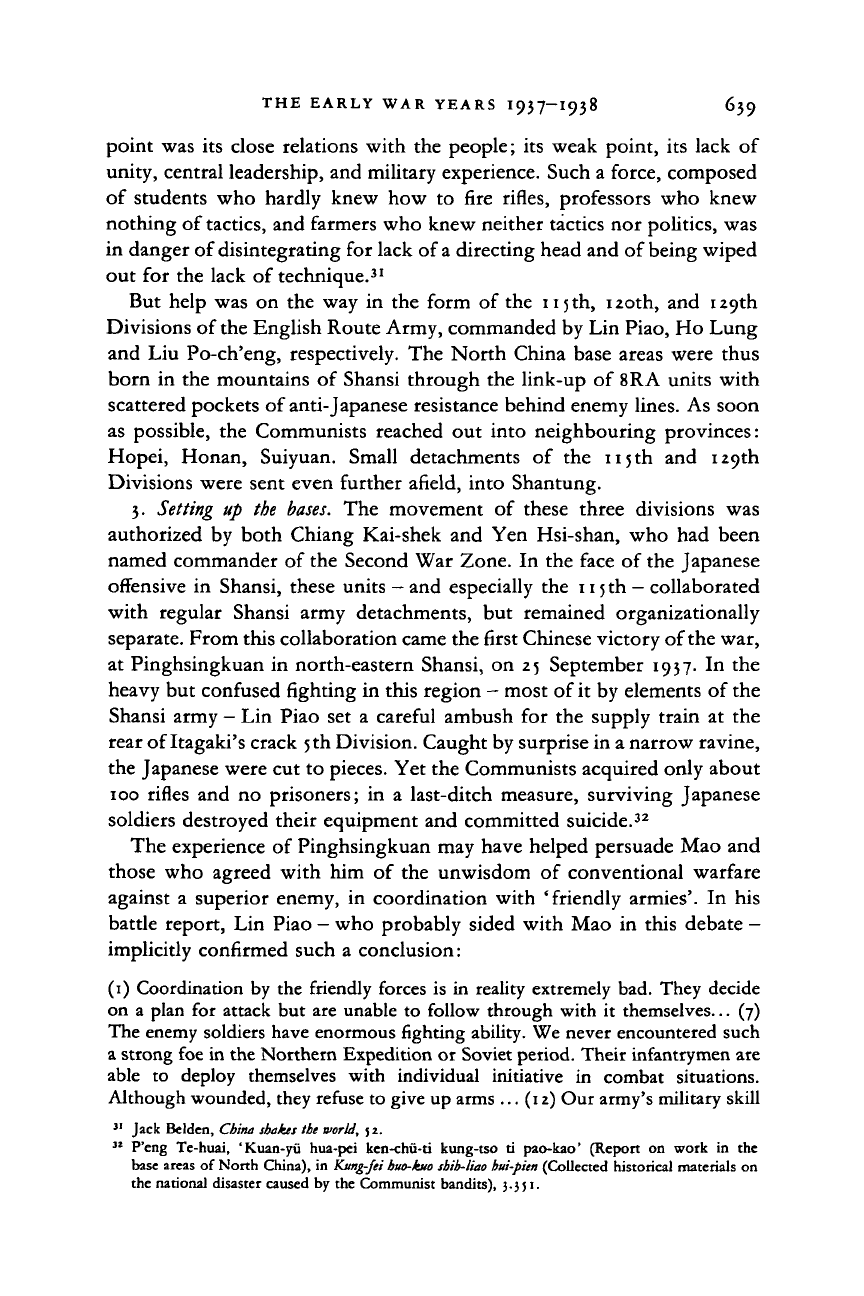
THE EARLY WAR YEARS I937—1938 639
point was its close relations with the people; its weak point, its lack of
unity, central leadership, and military experience. Such a force, composed
of students who hardly knew how to fire rifles, professors who knew
nothing of
tactics,
and farmers who knew neither tactics nor politics, was
in danger of disintegrating for lack of
a
directing head and of being wiped
out for the lack of technique.
31
But help was on the way in the form of the
115
th,
120th, and 129th
Divisions of
the
English Route Army, commanded by Lin Piao, Ho Lung
and Liu Po-ch'eng, respectively. The North China base areas were thus
born in the mountains of Shansi through the link-up of 8RA units with
scattered pockets of anti-Japanese resistance behind enemy lines. As soon
as possible, the Communists reached out into neighbouring provinces:
Hopei, Honan, Suiyuan. Small detachments of the 115th and 129th
Divisions were sent even further afield, into Shantung.
3.
Setting up the
bases.
The movement of these three divisions was
authorized by both Chiang Kai-shek and Yen Hsi-shan, who had been
named commander of the Second War Zone. In the face of the Japanese
offensive in Shansi, these units - and especially the
115
th - collaborated
with regular Shansi army detachments, but remained organizationally
separate. From this collaboration came the first Chinese victory of the war,
at Pinghsingkuan in north-eastern Shansi, on 25 September 1937. In the
heavy but confused fighting in this region - most of it by elements of the
Shansi army - Lin Piao set a careful ambush for the supply train at the
rear of Itagaki's crack
5
th Division. Caught by surprise in a narrow ravine,
the Japanese were cut to pieces. Yet the Communists acquired only about
100 rifles and no prisoners; in a last-ditch measure, surviving Japanese
soldiers destroyed their equipment and committed suicide.
32
The experience of Pinghsingkuan may have helped persuade Mao and
those who agreed with him of the unwisdom of conventional warfare
against a superior enemy, in coordination with 'friendly armies'. In his
battle report, Lin Piao - who probably sided with Mao in this debate -
implicitly confirmed such a conclusion:
(1) Coordination by the friendly forces is in reality extremely bad. They decide
on a plan for attack but are unable to follow through with it themselves... (7)
The enemy soldiers have enormous
fighting
ability. We never encountered such
a strong foe in the Northern Expedition or Soviet period. Their infantrymen are
able to deploy themselves with individual initiative in combat situations.
Although wounded, they refuse to give up arms ... (12) Our army's military skill
31
Jack Beldcn, China shakes the
world,
52.
" P'eng Te-huai, 'Kuan-yu hua-pei kcn-chu-ti kung-tso ti pao-kao' (Report on work in the
base areas of North China), in
Kung-fei buo-kuo sbib-liao hui-pien
(Collected historical materials on
the national disaster caused by the Communist bandits),
3.551.
Cambridge Histories Online © Cambridge University Press, 2008
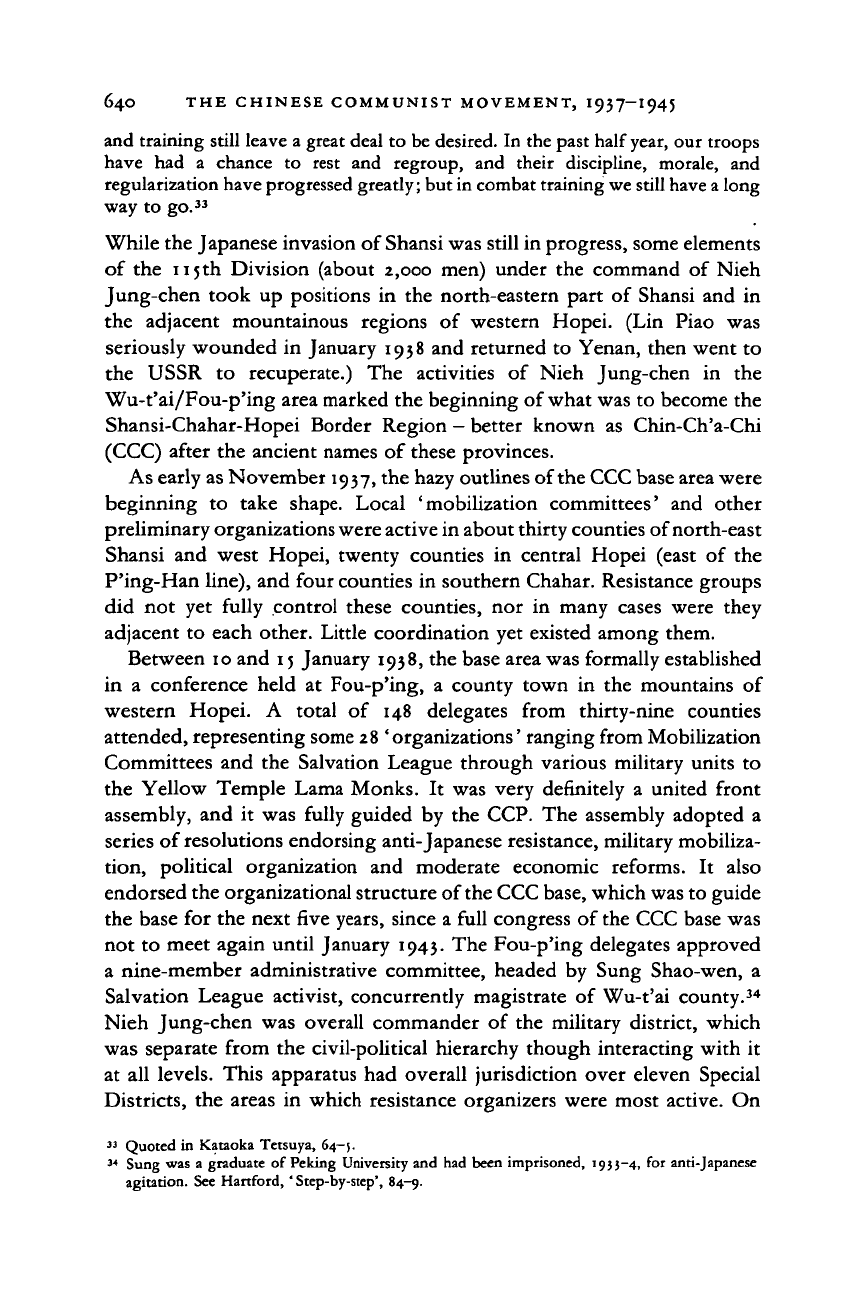
640 THE CHINESE COMMUNIST MOVEMENT, 1937—1945
and training still leave a great deal to be desired. In the past half
year,
our troops
have
had a
chance
to
rest
and
regroup,
and
their discipline, morale,
and
regularization have progressed greatly; but
in
combat training
we
still
have
a
long
way to go.
33
While the Japanese invasion of Shansi was still in progress, some elements
of the 115th Division (about 2,000 men) under the command
of
Nieh
Jung-chen took
up
positions
in
the north-eastern part
of
Shansi and
in
the adjacent mountainous regions
of
western Hopei.
(Lin
Piao
was
seriously wounded in January 1938 and returned to Yenan, then went
to
the USSR
to
recuperate.)
The
activities
of
Nieh Jung-chen
in the
Wu-t'ai/Fou-p'ing area marked the beginning of what was to become the
Shansi-Chahar-Hopei Border Region
-
better known
as
Chin-Ch'a-Chi
(CCC) after the ancient names
of
these provinces.
As early as November
1937,
the hazy outlines of the CCC base area were
beginning
to
take shape. Local 'mobilization committees'
and
other
preliminary organizations were active in about thirty counties of north-east
Shansi
and
west Hopei, twenty counties
in
central Hopei (east
of
the
P'ing-Han line), and four counties in southern Chahar. Resistance groups
did
not yet
fully control these counties,
nor in
many cases were they
adjacent
to
each other. Little coordination yet existed among them.
Between 10 and 15 January 1938, the base area was formally established
in
a
conference held
at
Fou-p'ing,
a
county town
in
the mountains
of
western Hopei.
A
total
of 148
delegates from thirty-nine counties
attended, representing some 28 'organizations' ranging from Mobilization
Committees and the Salvation League through various military units
to
the Yellow Temple Lama Monks.
It
was very definitely
a
united front
assembly, and
it
was fully guided
by
the CCP. The assembly adopted
a
series of resolutions endorsing anti-Japanese resistance, military mobiliza-
tion, political organization
and
moderate economic reforms.
It
also
endorsed the organizational structure of the CCC base, which was to guide
the base for the next five years, since a full congress of the CCC base was
not to meet again until January 1943. The Fou-p'ing delegates approved
a nine-member administrative committee, headed
by
Sung Shao-wen,
a
Salvation League activist, concurrently magistrate
of
Wu-t'ai county.
34
Nieh Jung-chen was overall commander
of
the military district, which
was separate from the civil-political hierarchy though interacting with
it
at all levels. This apparatus had overall jurisdiction over eleven Special
Districts, the areas
in
which resistance organizers were most active.
On
33
Quoted
in
Kataoka Tetsuya, 64-5.
34
Sung was
a
graduate
of
Peking University
and had
been imprisoned, 1935-4,
for
anti-Japanese
agitation. See Hartford, 'Step-by-step', 84-9.
Cambridge Histories Online © Cambridge University Press, 2008
